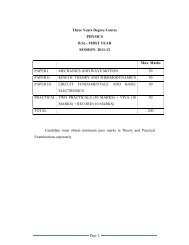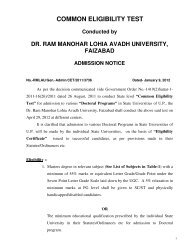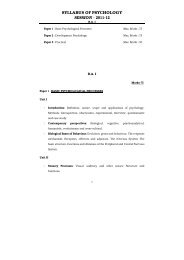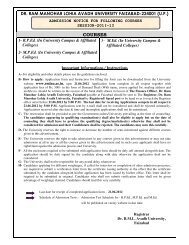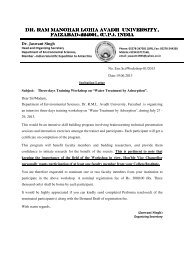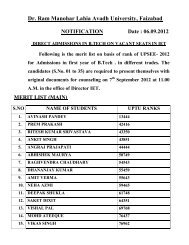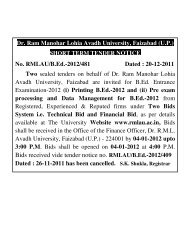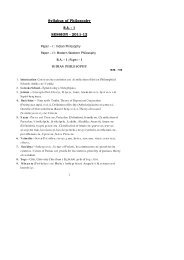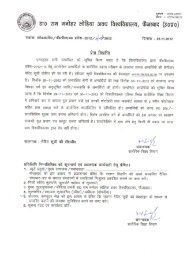B.Sc-Part-I(BOTANY)
B.Sc-Part-I(BOTANY)
B.Sc-Part-I(BOTANY)
- No tags were found...
Create successful ePaper yourself
Turn your PDF publications into a flip-book with our unique Google optimized e-Paper software.
Syllabus for B.<strong>Sc</strong>. BotanyB.<strong>Sc</strong>. I yearSession - 2011-12There will be Three theory papers and a practical examination as follows:Paper I - Diversity of Viruses, Bacteria & Fungi M. M.: 50Paper II - Diversity of Algae, Lichens, & Bryophytes M. M.: 50Paper III - Diversity of Pteridophytes & Gymnosperms M. M.: 50(There will be 9 questions in each paper and candidate has to attempt only 5 questions. Q.1 will be compulsorybased on units I - IV. Two questions will be set from each unit of which one question has to be attempted. Allquestions will carry equal marks.Practicals: Based on papers I - III M. M.: 50The course detailes are as follows:-Paper I: Diversity of Viruses, Bacteria, & Fungi M.M. 50Unit-IHistory, nature and classification of Viruses, Bacteria and Fungi.History of virology and bacteriology; prokaryotic and eukaryotic cell structure (bacteria, mycoplasma andyeast); structure, classification and nature of viruses; structure (gram positive and gram negative) andclassification (based on cell structure) of bacteria; classification, thallus organisation and reproduction infungi; economic importance of fungi.Unit-IIViruses:Symptoms of virus infection in plants; transmission of plant viruses; genome organisation, replication ofplant virus (tobacco mosaic virus); techniques in plant viruses - purification, serology and electron microscopy;structure and multiplication of bacteriophages; structure and multiplication of viroids.Unit-IIIBacteria:Nutritional types of bacteria (based on carbon and energy sources), metabolism in different nutritionaltypes (basics only) and nitrogen cycle; bacterial genome and plasmids; bacterial cell division, variability inbacteria - mutation, principles of genetic recombination; techniques in sterilisation, bacterial culture and staining;economic importance.Unit-IVFungi:The characteristics and life cycles of the following:Mastigomycotina: Albugo, Pythium,; Ascomycotina: Saccharomyces, Aspergillus; Ascobolus;Basidiomycotina : Ustilago, Puccinia, Polyporus, Agaricus; Deuteromycotina: Fusarium.1
Paper II - Diversity of Algae, Lichens, and Bryophytes M.M. 50Unit-IGeneral characters. Range of thallus organization, classification, ultrastructure of eukaryotic algal cell andcyanobacterial cell, economic importance of algae. Lichens, classification, thallus organization, reproduction,physiology and role in environmental pollution.Unit-IIThe characteristics and life cycles of the following:-Cyanophyta Microcystis, Oscillatoria :Chlorophyta Volvox, Hydrodictyon, Oedogonium, Coleochaete,Chara; Bacillariophyta Navicula; Xanthopyta Vaucheria; Phaeophyta; EctocarpusRhodophyta PolysiphoniaUnit – IIIBryophytes, general characters, classification, reproduction and affinities. Gametophytic and soporophyticorganization of:Bryopsida: Pogonatum; Anthocerotopsida: AnthocerosUnit - IVGametophytic and sporophytic organization of Hepaticopsida : Riccia, Marchantia.Paper III – Diversity of Pteridophytes, Gymnosperms and elementary Palaeobotany M.M. 50Unit - IPteridophytes: General features, classification, stellar system and its evolution. Comparative study ofmorphology, anatomy, development, vegetative and reproductive systems of following:Lycopsida - Lycopodium, Selaginella;Psilopsida- RhyniaUnit – IIGeneral and comparative account of gametophytic and sprophytic system inFilicopsida -Pteridium, Nephrolepis. Marsilea.Heterospory and seed habit.Unit - IIIGymnosperms: General characters, classification. Comparative study of morphology, anatomy, developmentof vegetative and reproductive parts in:Cycadales: CycasUnit –IVStudy of morphology, anatomy, development and reproductive parts in:Coniferales – Pinus ; Gnetales - EphedraAffinities and relationship of Gymnosperms, evolutionary significance.Elementary Palaeobotany: general account, types of fossils, methods of fossilization and geological time scale.2




